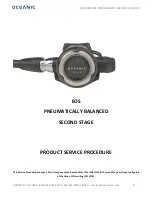
3. OPERATION
3.1 VOLTAGE MEASUREMENTS
1. Turn off power to the circuit/device under test and discharge all capacitors.
2. Plug the black test lead into the COM input jack on the meter and connect the
test lead tip to a grounded point (the reference point for measured voltage).
3. Select the desired AC voltage range (V
), or DC voltage range (V
). If the
magnitude of the voltage to be measured is unknown, always start with the
highest range.
4. Plug the red test lead into the volt input jack on the meter and connect to the
circuit where a voltage measurement is required. Voltage is always measured in
parallel across a test point.
5. Energise the circuit or device under test and make the voltage measurements.
Reduce the range setting if set too high until a satisfactory best resolution read-
ing is obtained.
6. After completing the measurement, turn off the power to the circuit / device
under test, discharge all capacitors and disconnect the meter test leads.
6
WARNING
To avoid possible electric shock, instrument damage and / or equip-
ment damage, do not attempt to take any voltage measurements
if the voltage is above 1000V DC or 750VAC. These are the maximum
voltages that this instrument is designed to measure. The "COM"
terminal potential should not exceed 500V measured to ground.
Display:
3½ 17mm large LCD, maximum reading 3200 with function and units
sign annunciators. Display update rate 2 times per second, nominal.
Analogue bar graph:
34 segments with measurements 12 times per second
Polarity Indication:
Automatic, positive implied, negative indicated.
Overrange Indication:
(OL) is displayed.
Low Battery Indication:
The "
" is displayed when the battery voltage drops
below accurate operating level
Auto Power Off:
Clampmeter automatically shuts down after approx 10 minutes
of inactivity.
Operating Environment:
0°C to 50°C at <70% Relative Humidity.
Storage Environment:
-20°C to 60°C at <80% Relative Humidity with battery
removed from meter.
Temperature Coefficient:
0.1 X (specified accuracy) / °C (<18°C or >28°C)
Altitude:
6561.7 Feet (2000M)
Power:
Standard 9-volt battery, NEDA 1604, IEC 6F22, JIS 006P PP3.
Battery Life:
300 hours typical with alkaline battery.
Jaw Opening Capability:
57mm conductor, 70 X 18mm bus bar.
Size (H x W x D):
10.9 x 4.0 x 1.9 inches (277 x 102 x 49mm)
Weight: Approx:
18.9 OZ/ 540grams (including battery).
Specification
CM56 Clamp Meter




























